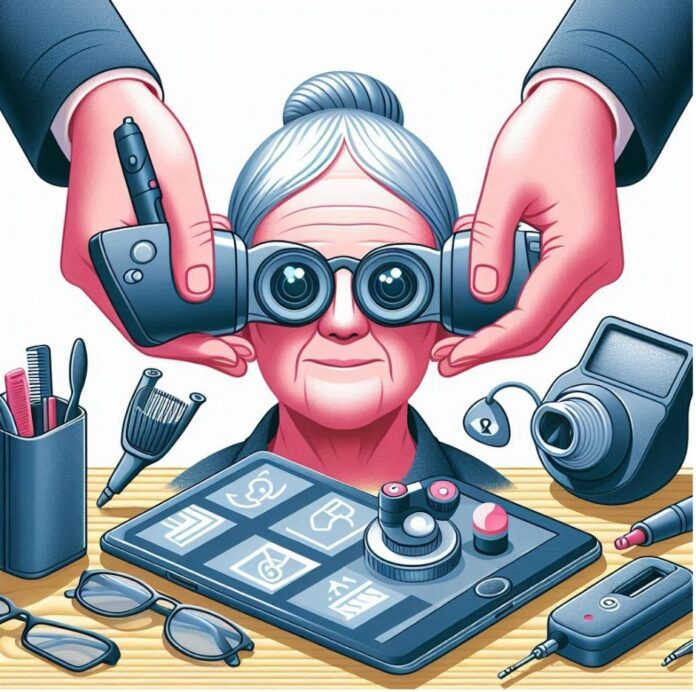Navigating the world with visual impairments can be challenging, but advancements in assistive technology have made a significant difference. These devices empower individuals to live more independently and confidently. However, to ensure optimal performance and longevity, proper care and maintenance are essential. This comprehensive guide will delve into the intricacies of caring for your visual assist devices, helping you maximize their benefits and minimize downtime.
Key Highlights
- Proper care extends the lifespan of visual assistive devices and ensures optimal performance.
- General care tips include handling with care, regular cleaning, moisture protection, proper storage, software updates, and data backups.
- Specific care instructions vary by device type, but most require lens cleaning, software updates, and regular inspections.
Image Credit Goes to Florida Vision Technology
Understanding the Importance of Care
The best assistive device for the visually impaired is the one that consistently meets your needs and provides reliable support. Proper care not only extends the lifespan of your device but also prevents performance degradation, ensuring you get the most out of your investment. Neglecting maintenance can lead to costly repairs or replacements, interrupting your daily routine and causing unnecessary frustration.
Common Types of Visual Assist Devices
Before diving into care and maintenance, let’s briefly explore some common types of visual assist devices:
- Magnifiers: These devices enlarge text and images, making them easier to read. They come in various forms, including handheld, electronic, and video magnifiers.
- Screen Readers: These software applications convert text on a computer screen into speech or Braille, allowing users to access digital content.
- Braille Displays: These devices translate electronic text into Braille, providing tactile feedback for reading.
- Optical Character Recognition (OCR) Software: This software scans printed text and converts it into digital format, which can then be read by screen readers or magnified.
- Closed-Circuit Television (CCTV): CCTV systems use a camera to capture images, which are then displayed on a larger screen with enhanced contrast and magnification.
General Care Tips
While specific care instructions may vary depending on the device, these general guidelines apply to most visual assist devices:
- Handle with care: Avoid dropping or subjecting your device to harsh conditions.
- Clean regularly: Use a soft, lint-free cloth to gently wipe away dust, fingerprints, and smudges. Avoid using harsh chemicals or abrasive materials.
- Protect from moisture: Moisture can damage electronic components. Keep your device away from water and humidity.
- Store properly: When not in use, store your device in a safe, clean place. Use protective cases or covers if available.
- Update software: Keep your device’s software up-to-date to benefit from the latest features and security improvements.
- Back up data: Regularly back up important files and settings to protect against data loss.
Care for Specific Devices
- Magnifiers:
- Handle the lenses with care to avoid scratches.
- Clean lenses regularly with a lens cleaning solution and a microfiber cloth.
- Protect the device from drops and impacts.
- For electronic magnifiers, follow the manufacturer’s instructions for battery care and charging.
- Screen Readers:
- Keep the computer or device clean and free of dust.
- Update the operating system and screen reader software regularly.
- Adjust screen brightness and contrast for optimal viewing.
- Braille Displays:
- Clean the Braille cells gently with a soft cloth.
- Protect the device from dust and moisture.
- Follow the manufacturer’s instructions for battery care and charging.
- OCR Software:
- Ensure the scanning surface is clean and free of debris.
- Calibrate the scanner regularly for accurate results.
- Update the OCR software to improve performance.
- CCTV Systems:
- Keep the camera lens clean.
- Adjust the focus and zoom settings as needed.
- Regularly clean the monitor screen.
Troubleshooting Common Issues
- Device not turning on: Check the power source, batteries, or charging cable.
- Device is unresponsive: Restart the device or try a different power source.
- Image quality is poor: Clean the lenses, adjust focus and settings, or check for software updates.
- Device is making unusual noises: This could indicate a hardware issue. Contact the manufacturer for support.
Preventive Maintenance
Regular maintenance is crucial for keeping your visual assist devices in optimal condition and extending their lifespan. Consider the following:
- Professional cleaning: Schedule regular professional cleanings for complex devices to ensure they function effectively.
- Battery care: Follow the manufacturer’s recommendations for battery care, including proper charging cycles and storage practices.
- Software updates: Keep your device’s software up-to-date with the latest patches and security fixes to maintain performance and security.
- Regular inspections: Periodically inspect your device for signs of wear and tear and address any issues promptly to avoid further complications.
Additional Tips for Optimal Use
- Ergonomics: Set up your workspace to prevent discomfort and fatigue.
- Lighting: Ensure adequate lighting for optimal performance of your device.
- Accessibility features: Explore additional accessibility features available on your computer or smartphone.
- Backup devices: Consider having a backup device in case of emergencies.
- Professional support: Seek guidance from low vision specialists or assistive technology experts.
Conclusion
Proper care and maintenance of your visual assist devices are essential for maximizing their benefits and ensuring long-term reliability. By following the tips outlined in this guide, you can protect your investment, enhance your independence, and improve your overall quality of life. Remember, regular maintenance and attention to detail are key to enjoying the full potential of your assistive technology.



